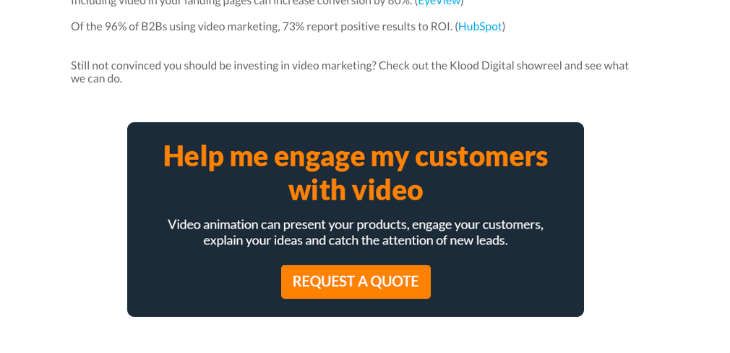These things help you to achieve that, but sometimes it’s the simpler things that can have the biggest impact.
Have you ever taken the time to craft quality website copy? As long as you accurately describe your products and services this might seem like a minor point. However, study after study has demonstrated the importance of writing quality content if you want to generate more leads.
Know who you’re trying to target
Before you put pen-to-paper (well, finger to keyboard) you need to have a clear idea in your mind of who you’re writing for — and the more specific the better.
This means working out who isn’t your target market just as much as working out who is. For example, if your organisation sells swimming pools you aren’t just targeting homeowners, you’re targeting affluent homeowners who probably live an active lifestyle.
Once you know who you’re writing for you’ll be able to identify what language and sales hooks would be most effective. Continuing with our swimming pools example, that audience don’t want to hear about how affordable the pools are — budget probably isn’t their primary concern — but the benefits of owning one (more on this point later).
Identifying your buyer personas can help a lot with this, and if you haven’t done that yet, stop reading this blog now and come back to it after checking out our Ultimate Guide to Identifying Your Buyer Personas.
The headline is half the battle
This blog is all about writing great web copy that helps you to convert web visitors into leads and customers, but first of all you need to get people to that content.
When it comes to blogs and content offers it’s all about the headline. This blog, 6 Steps to Writing Awesome Article Titles that Drive Traffic, will help you do that.
But what about titles for pages on your website? There’s a couple of things to consider here.
First of all, the page title (the title that appears at the top of the browser window) is what will appear in the search rankings and so needs to take in to account SEO. The page title is a ranking factor and therefore needs your keyword in it, but it’s also important to be as clear and concise about what the page is about as possible.
Regarding internal links on your website, you’ll want to make sure the majority of them are based closely on the subject of the page you’re linking to, but you can still experiment. For example, on our ‘Problems We Solve’ page, we use content around the links to give more context to what they’ll find if they click.

Let’s imagine there’s an online fitness and leisure retailer. As I’m an unashamed narcissist, let’s call it Rooney Fitness.
Rooney Fitness sells running shoes and other accessories, and a reasonable internal link from the navigation would be just that. However, what if we changed it to ‘Improve My Fitness’? This speaks directly to what the user wants much more than ‘Running Shoes and Accessories’ would.
Write to the reader
You’re probably thinking, ‘well yeah… obviously?’
But what this refers to specifically is writing copy in a way that makes it seem as though you’re addressing the reader directly — and it’s amazing how few organisations do this.
It’s a simple concept and easy to implement once you get your head round it. It involves talking about yourself less and addressing the reader as ‘you’. Look at this example from our Inbound Marketing page:
"You’ll search firstly to define your problem, then for solutions, and finally, once you’ve got three or four options, you’ll look for reviews and comparisons. By the time you’re ready to contact a vendor, you’ve done your own research, you know what you want to buy, who you want to buy it from and how much you want to pay for it. This is where inbound marketing comes in."
We don’t just explain what inbound marketing is, we explain how it relates to the reader and how it can help them.
Write about the benefits — not the solution
So, you sell great products that are well made and great value for… blah, blah, blah. No one cares. Seriously.
It’s great that you’ve developed a great product or service, but people don’t want to hear about that. They want to know how what you sell is going to help them solve the problems they have.
A study conducted by Harvard researchers back in 2012 found that we’ve reached the end of ‘solution sales’. The modern consumer already knows what they’re looking for — your job when writing your copy is to convince them of the benefits of your product, not simply what it is.
Facts and stats are great for supporting the claims you’re making about your products’ benefits. Let’s go back to the Rooney Fitness example. Which of these lines is more persuasive?
Rooney Fitness running shoes will help you run harder and faster, beating your personal best.
75% of Rooney Fitness customers have found these running shoes help them to beat their personal best.
The second one is much more tangible. Make sure you can support your claims of course — don’t just make stats up!
Less is more
It’s important to make sure you’ve included all the benefits offered by your products, but don’t overwrite.This is harder than it sounds — especially if you think you’ve written a beautifully worded paragraph that you can’t bear to cut.
Focus on identifying the core benefits of your products and write about them in as few words as possible. Avoid too many adverbs — they rarely add value to what you’re saying — keep sentences short and break up those paragraphs.
Check out this blog on content formatting tips for boosting user engagement for more on keeping the user interested.
On a related point, write your copy like a human. Writing conversationally doesn’t mean using slang or colloquialisms, but it does mean avoiding jargon and corporate-speak. If your copy sounds like the keynote address at a business management conference, rewrite it.
Provide clear CTAs
If you’ve done all that, then great, but your web visitors still won’t convert if you don’t show them how.
This means making it clear what they need to do next, whether that’s purchase a product, book a consultation or download a content offer.

Make your call-to-action buttons large and clear, while keeping the number of steps a user needs to take to get to the checkout as low as you can.
Test everything
Finally, test every element of your web pages.
From the words you use and the placement of CTAs, through to font size and what images you use. Remember to test one thing at a time to isolate what is making the difference to conversion rates.
Regarding copy specifically, A/B test headlines and subheadings, the copy in your CTAs as well as your opening paragraph.
Want to discover other strategies for generating more leads online? Download our free eBook, ‘9 Things You Can Do to Generate More Leads’, below.
Stay Updated with Our Latest Insights
Get expert HubSpot tips and integration strategies delivered to your inbox.



